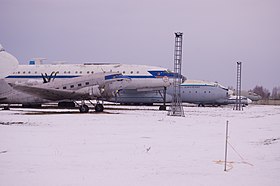Air accident at Namzew
| Air accident at Namzew | |
|---|---|
|
A Lissunow Li-2 in the foreground |
|
| Accident summary | |
| Accident type | Failure of both engines after interruption of the fuel supply |
| place | Near Namzew , Russian Soviet Federal Socialist Republic , Soviet Union |
| date | December 27, 1951 |
| Fatalities | 20th |
| Survivors | 0 |
| Aircraft | |
| Aircraft type |
Lissunow Li-2 , Soviet Union |
| operator |
Aeroflot , Soviet Union |
| Mark | CCCP-L4228, Soviet Union |
| Departure airport |
Yakutsk Airport , Russian Soviet Socialist Federative Republic , Soviet Union |
| Destination airport |
Vilyuisk Airport , Russian Soviet Federal Socialist Republic , Soviet Union |
| Passengers | 14th |
| crew | 6th |
| Lists of aviation accidents | |
On December 27, 1951, there was an aircraft accident at Namzew , in which all 20 occupants died. The used Lisunov Li-2 of the Aeroflot should have an internal Soviet line flight of Jakutsk according Vilyuysk fly.
Plane and crew
The aircraft was a Lissunow Li-2 (aircraft registration number : CCCP-L4228, serial number : 18421601), which had completed 4,429 flight hours from June 12, 1945 until the accident.
The crew consisted of the flight captain Nikolai Andrejewitsch Schebanow, the first officer Vladimir Sotowitsch Kondratjew, the flight engineer Serafim Danilowitsch Tschernow, the navigator Sergei Andrejewitsch Schilonosow, the radio operator Gennadi Andrejewitsch Morschtschinin, and an employee of the local aviation department Fyodor Michailowitschinin.
course
The Li-2 took off at 3:55 am Moscow time (MSK). The last radio contact was made at 4:22 a.m. MSK. The pilots reported a cloud base of 1,000 m, a visibility of 4 km and a temperature of −30 ° C. They did not answer the following radio messages.
At 4:26 a.m. MSK, first the right and then the left engine failed at an altitude of 1,000 m. This can be concluded from the fact that the pilots initially tried to bring the propeller of the right engine into the sail position and continue to fly with a single engine. When the left engine also failed, they stopped their attempts. Thereupon Captain Schebanow saw the woodless, 2 km long and 80-120 m wide river bed of the Tarasas as the only landing possibility , whereby he could not accomplish the necessary calculations. In order to be able to reach the river bed in gliding flight, the pilots set the lever for the speed control to high level. Incorrectly, they also extended the landing gear , which they tried to retract at the last moment. Ultimately, the machine lost speed and rolled to the left until it hit the left wing at an angle of 60 ° with no forward speed approx. 200 m in front of the river bed. The burned-out wreck was found 90 km north of Yakutsk near Namzew.
root cause
It was found that the engines failed because the pilots chose the almost empty rear left tank, which could be read on the corresponding switch. Although there was no record of the amount, there were at least 1,217 kg of fuel on board at the time of take-off. According to a flight engineer, there were 150 kg of fuel in the rear left tank at the time of the handover to the accident crew. Then another 40 kg was removed to check the engines.
When the engines failed, the pilots behaved chaotically; they extended the landing gear and did not turn off the ignition for the engines. The fact that the newly formed crew flew an Li-2 for the first time without having previously completed appropriate training with a performance check was regarded as an accident factor. In addition, the lack of support for Captain Shebanov, for whom the flight involved in the accident was the very first unattended flight after a 7-month break, was criticized by the management of the Yakutsk Aviation Department, despite the fact that it had many incidents.
swell
- Accident description (English) Li-2 CCCP-L4228 on the Aviation Safety Network , accessed on August 1, 2020
- Description of the accident (Russian) on airdisaster.ru, accessed August 1, 2020
- Description of the accident (Russian) on avia.pro, accessed on August 1, 2020
